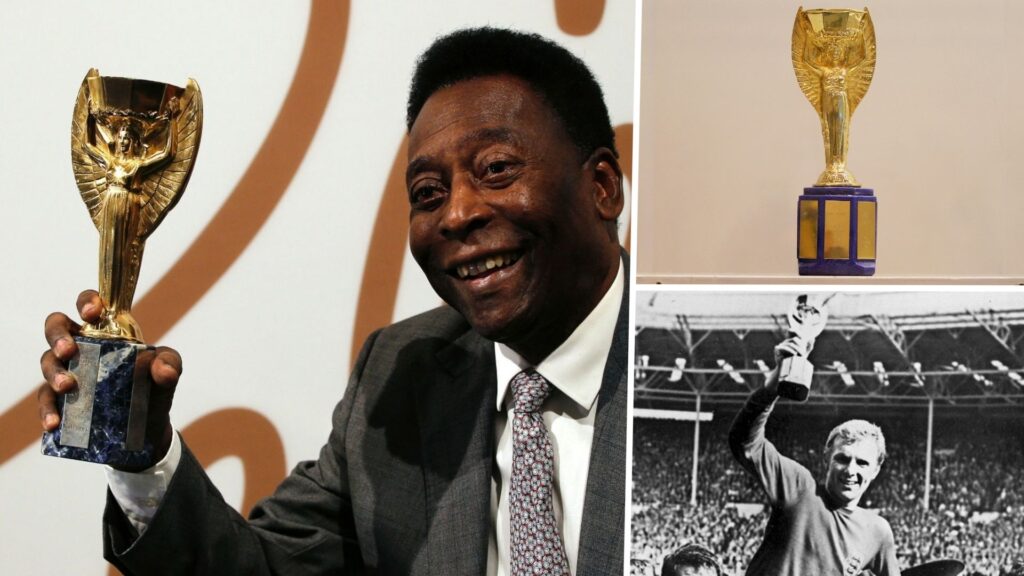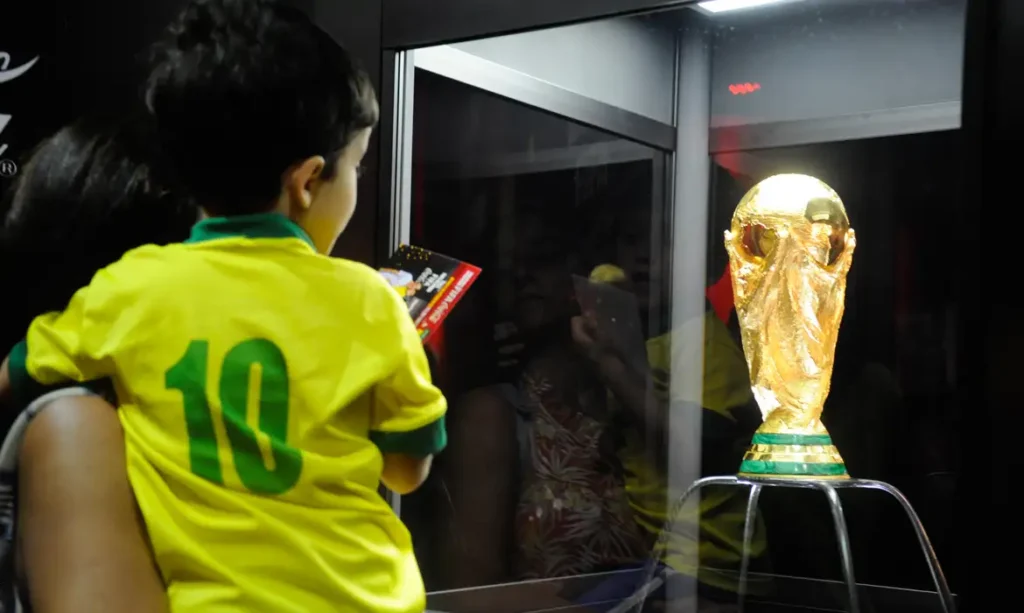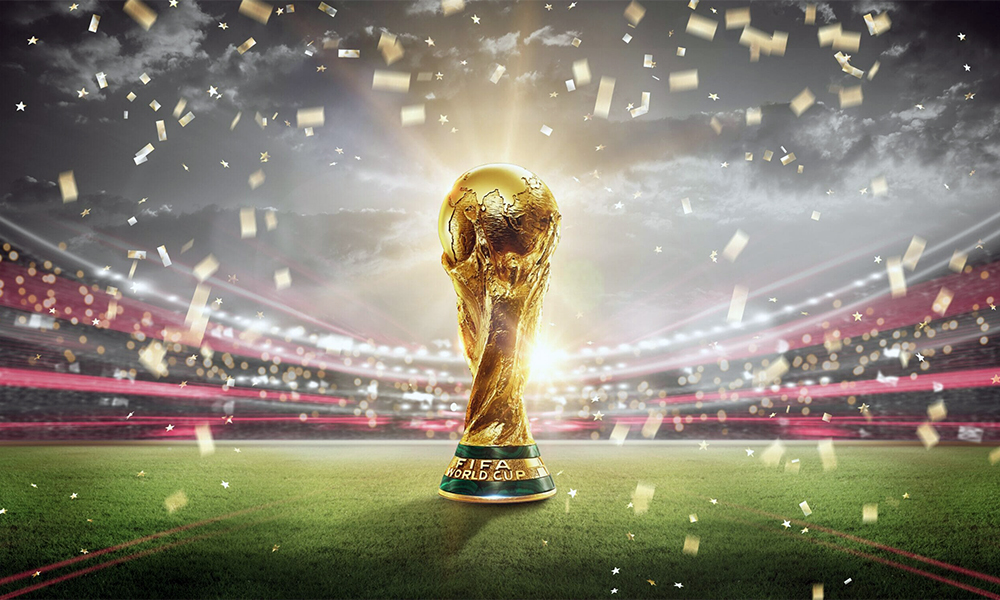From Jules Rimet to FIFA Trophy: The Evolution of World Cup Trophy
It’s the ultimate prize in football, the symbol of global supremacy instantly recognized by billions. Lifting the World Cup trophy is the dream of every player, the culmination of national hopes and years of dedication. But the gleaming golden statue we see today isn’t the original prize. The journey of the World Cup trophy itself is a fascinating story, involving theft, war, legendary winners, and evolving design.
From the elegant “Victory” statue named after FIFA’s visionary president to the dynamic modern sculpture representing global triumph, the trophy embodies the history and prestige of the tournament. Understanding its evolution adds depth to the celebrations we witness every four years.
Follow the captivating history of football’s most coveted prize
1. The Original: The “Victory” Trophy (Later Jules Rimet)
- Commissioned For: The first World Cup in 1930.
- Design: Created by French sculptor Abel Lafleur, it depicted Nike, the Greek goddess of victory, holding an octagonal cup aloft. Made of gold-plated sterling silver on a lapis lazuli base, it stood 35 cm tall and weighed 3.8 kg.
- Nickname: Initially just called “Victory” or “World Cup.”
2. Hidden During World War II
- The Protector: Ottorino Barassi, the Italian vice-president of FIFA and president of the Italian FA, secretly took the trophy home from a bank in Rome in 1939 as war loomed.
- The Hiding Place: To keep it safe from occupying Nazi forces who might covet it, Barassi hid the trophy in a shoebox under his bed throughout the war. A humble hiding spot for football’s greatest prize!
3. Renamed in Honour of Rimet (1946)
- The Tribute: Following World War II, in recognition of Jules Rimet’s 25th anniversary as FIFA President and his role in establishing the tournament, the World Cup trophy was officially renamed the “Jules Rimet Cup” in 1946.
4. The First Theft: England 1966
- The Incident: Just four months before the 1966 World Cup in England, the Jules Rimet trophy was stolen while on public display at Westminster Central Hall.
- The Search: A major police investigation and nationwide search ensued, causing significant embarrassment for the hosts.
- The Hero: Seven days later, a dog named Pickles famously sniffed out the trophy wrapped in newspaper under a hedge in South London while out for a walk with his owner, David Corbett. Pickles became a national celebrity.
5. Brazil Earns Permanent Possession (1970)
- The Rule: Jules Rimet had stipulated in 1930 that any nation winning the World Cup three times would keep the trophy permanently.
- The Triumph: Brazil achieved this feat by winning their third title in Mexico in 1970, led by Pelé. They were awarded the original Jules Rimet trophy outright.

6. The Second Theft: Brazil 1983
- The Heist: The Jules Rimet trophy was kept on display at the Brazilian Football Confederation (CBF) headquarters in Rio de Janeiro. In December 1983, thieves broke into the building, overpowered the nightwatchman, and stole the trophy from its bulletproof glass case (the back of which was reportedly made of wood and easily pried open).
- The Fate: Despite arrests, the original trophy was never recovered. It is widely believed to have been melted down and sold as gold bullion. A tragic end for a piece of sporting history.
- The Replica: The CBF commissioned a replica, made by Eastman Kodak using 1.8 kg of gold, which is now displayed in its place.
7. Designing a New Trophy (Post-1970)
- The Need: After Brazil permanently claimed the Jules Rimet trophy in 1970, FIFA needed a new prize for the 1974 World Cup onwards.
- The Competition: FIFA received 53 submissions from sculptors in seven countries for the design of a new trophy.
- The Winner: Italian artist Silvio Gazzaniga’s design was chosen.

8. The Current FIFA World Cup Trophy: Design
- Description: Gazzaniga described his creation: “The lines spring out from the base, rising in spirals, stretching out to receive the world. From the remarkable dynamic tensions of the compact body of the sculpture rise the figures of two athletes at the stirring moment of victory.”
- Material: It stands 36.8 cm tall, weighs 6.175 kg, and is made of 18-carat solid gold with a base containing two layers of malachite.
- Symbolism: It depicts two human figures holding up the Earth, representing the global nature of the tournament and the ultimate triumph.
9. Not Permanently Awarded
- The Rule Change: Unlike the Jules Rimet trophy, the current FIFA World Cup trophy is not awarded to three-time winners permanently.
- The Practice: The winning team receives the authentic solid gold trophy during the official post-final ceremony but does not get to keep it long-term.
10. The Winner Keeps a Replica
- The Prize: After the celebrations, the winning nation is given a gold-plated bronze replica, known as the FIFA World Cup Winner’s Trophy, to keep permanently.
- Distinction: This replica is identical in size but differs in material from the solid gold original.
11. Engravings on the Base
- The Record: The underside of the authentic trophy’s base has a plaque where the names of the winning countries and the year of their triumph are engraved.
- Space: There was space for winners up to the 2038 World Cup. It’s unclear what will happen when the space runs out – likely a new base plaque.
12. Who Gets to Touch It?
- The Exclusivity: FIFA regulations state that the original solid gold trophy can only be touched and held by a very select group: former winners of the FIFA World Cup and heads of state.
- Ceremonial Handling: During the final ceremony, it’s presented by a representative of the previous winning nation or another dignitary.
13. The Trophy Tour
- Global Showcase: In the months leading up to each World Cup, the authentic trophy embarks on a global tour, visiting dozens of countries worldwide, allowing fans a chance to see the iconic prize up close (usually behind glass).

14. Value Beyond Gold
- Priceless: While its gold content gives it a substantial material value (estimated in the hundreds of thousands of dollars), its true value is symbolic and historical – making it essentially priceless in the sporting world.
15. The Sculptor: Silvio Gazzaniga
- Legacy: Gazzaniga, who passed away in 2016, not only designed the FIFA World Cup trophy but also other notable football trophies like the UEFA Cup (now Europa League trophy) and the UEFA Super Cup. His dynamic design for the World Cup remains his most famous legacy.
The journey of the World Cup trophy, from the elegance of the Jules Rimet Cup to the dynamism of the current FIFA trophy, mirrors the growth and evolution of the tournament itself – a story of passion, triumph, loss, and enduring global appeal.
Sources:
- FIFA.com (FIFA World Cup Trophy section, History articles)
- Wikipedia (FIFA World Cup Trophy, Jules Rimet Trophy)
- BBC Sport (The story of the World Cup trophies)
- Goal.com / ESPN (Articles on trophy history and facts)
- The Guardian (Articles on trophy thefts)
- Silvio Gazzaniga official website / obituaries
- News reports on Trophy Tours

